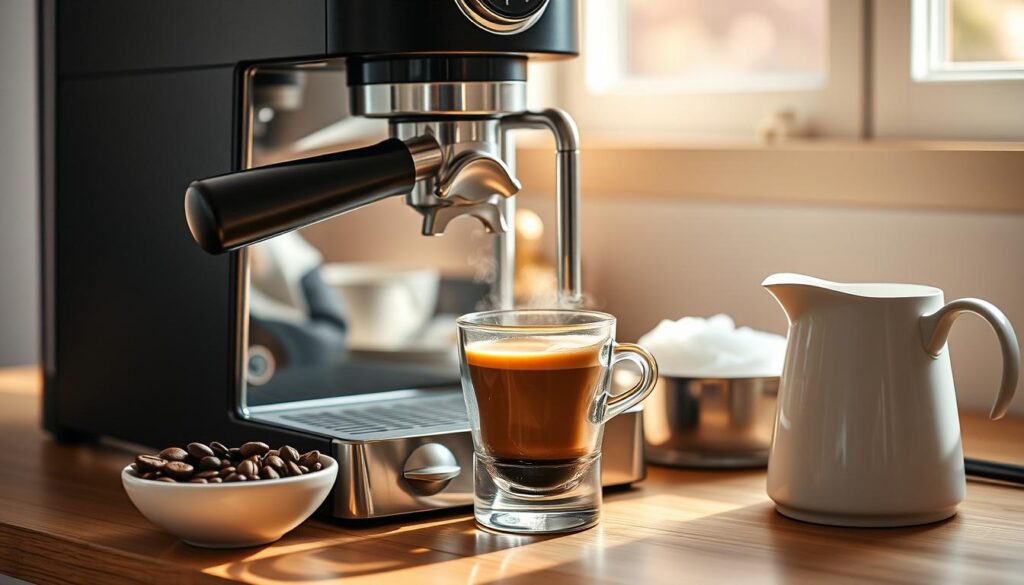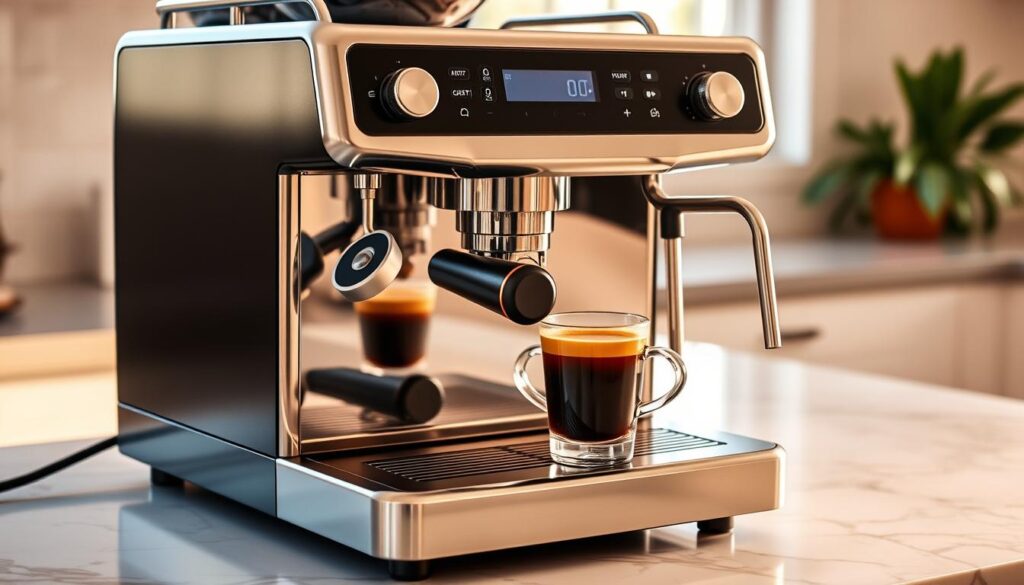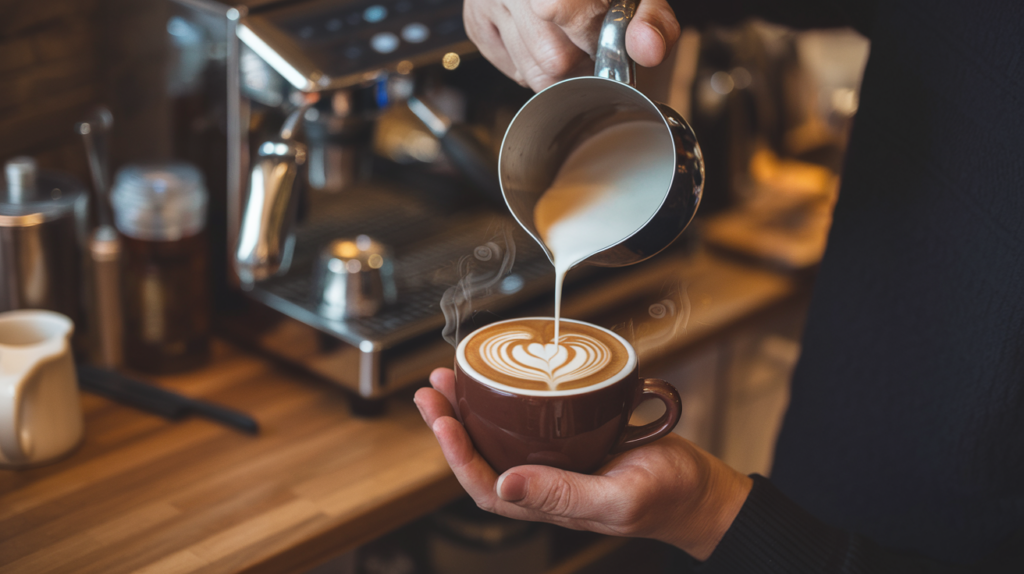This website contains affiliate links. As an Amazon Associate, I earn from qualifying purchases. The content on this website was created with the help of AI.
In recent years, making the perfect espresso has become a big deal for coffee lovers in the United States. This guide will turn your kitchen into a coffee paradise. It will show you how to make a rich, aromatic espresso, just like the ones from your favorite coffee shop.
We’ll cover the must-have equipment, picking the right coffee beans, and how to grind them. We’ll also dive into the espresso making process. By the end, you’ll know how to make every shot perfect in taste and texture.
Introduction to Espresso Making
Espresso is more than a coffee drink; it’s an Italian tradition loved worldwide. It’s known for its rich flavor and smooth texture. These qualities come from a precise brewing method.
The history of espresso began in the early 1900s in Italy. Luigi Bezzera invented the first espresso machine. It was designed to make coffee faster and better. Today, espresso is a key part of coffee culture, loved for its strong taste.
Espresso is made with fine ground coffee, high pressure, and hot water. This mix creates a rich, concentrated coffee with a golden crema. To make great espresso at home, you need to focus on details like grind size and extraction time.
Espresso is loved for its intense flavor. It’s perfect for making lattes and cappuccinos. It also gives a strong and aromatic coffee taste in one sip. Making espresso at home lets you enjoy this in your kitchen, with the added fun of creating it yourself.
Espresso making is an art that requires precision. Every step, from choosing the right beans to mastering extraction, affects the taste. A diy espresso guide helps make this process clear, so anyone can enjoy making espresso.
Essential Equipment for Homemade Espresso
Making espresso at home needs the right tools for a perfect shot every time. We’ll look at the key equipment for your home espresso brewing tutorial.
Espresso Machine
The espresso machine is the core of your setup. It’s crucial for making rich and flavorful shots. Choose a machine with good temperature control and consistent pressure. Brands like Breville, DeLonghi, and Gaggia are great for beginners and experts.
Coffee Grinder
A good coffee grinder is essential for crafting espresso at home. A burr grinder is best for its consistent grind. Look for brands like Baratza and Rancilio for the best grinders.
Portafilter
The portafilter holds the coffee grounds. A 58mm portafilter is recommended for most machines. Make sure it’s sturdy and made of stainless steel.
Other Tools and Accessories
There are also other tools that can improve your espresso-making:
- A tamper for even coffee grounds.
- A digital scale for precise coffee measurements.
- A milk frother for tasty lattes and cappuccinos.
- Cleaning brushes and solutions for your machine.
Here’s a comparison of essential equipment features:
| Equipment | Essential Features | Recommended Brands |
|---|---|---|
| Espresso Machine | Stable temperature control, consistent pressure | Breville, DeLonghi, Gaggia |
| Coffee Grinder | Uniform grind size, adjustable settings | Baratza, Rancilio |
| Portafilter | Durable, stainless steel, standard size | – |
| Additional Accessories | Tamper, digital scale, milk frother, cleaning tools | – |
Choosing the Right Coffee Beans
Choosing the right coffee beans is key to making great espresso at home. The flavor and quality of your espresso depend on the beans you pick. It’s important to know how different factors affect the taste of coffee beans.
The origin of the coffee beans greatly affects the taste. Beans from Central America are known for their bright acidity and fruity notes. Beans from Africa often have floral and berry flavors. Beans from Southeast Asia are earthy and robust.
The roast type also matters. Dark roasts are popular for their intense flavor. But, some people like medium or light roasts to show off the beans’ unique flavors. Freshness is crucial; using freshly roasted beans makes your espresso vibrant and aromatic.
“The best coffee beans for espresso are the ones that cater to your personal taste preferences. Don’t be afraid to experiment with different origins and roasts to find your perfect match.”
Here are some popular coffee bean options:
- Arabica Beans: Known for their sweet, complex flavors and lower acidity.
- Robusta Beans: Stronger, more bitter taste with higher caffeine content.
- Blends: Combines the best attributes of different beans for a balanced flavor.
When selecting coffee beans, consider these tips:
- Check the roast date: Always opt for beans with a recent roast date for maximum freshness.
- Buy in small quantities: Purchase smaller batches to ensure you use them while they’re fresh.
- Know your taste preference: Experiment with various origins and roast levels to discover your favorite.
To help you further in your decision-making process, here is a detailed comparison of different coffee bean origins and their attributes:
| Origin | Taste Profile | Popular Regions |
|---|---|---|
| Central America | Bright acidity, fruity notes | Costa Rica, Guatemala |
| Africa | Floral, berry flavors | Ethiopia, Kenya |
| Southeast Asia | Earthy, robust flavors | Indonesia, Vietnam |
Grinding Your Coffee Beans for Espresso
The journey to a perfect espresso starts with understanding the importance of grind size. This step is key in the espresso making process. It greatly affects the flavor and quality of your espresso shot. Grinding coffee beans correctly ensures optimal extraction and a balanced taste. Let’s dive into the key aspects of this process.
Finding the Perfect Grind Size
The grind size of your coffee beans is crucial in the espresso making process. A grind that’s too coarse will result in weak espresso. On the other hand, a grind that’s too fine can make the espresso taste bitter. The ideal grind for espresso is very fine, similar to powdered sugar. Achieving the perfect balance requires some experimentation.
Using a Burr Grinder
To ensure consistent grind size, using a burr grinder is highly recommended. Unlike blade grinders, which chop beans unevenly, a burr grinder crushes the beans between two surfaces. This method produces grinds of uniform size, essential for even extraction during the espresso making process. Investing in a quality burr grinder can significantly improve your espresso’s taste and quality.
Tips for Consistent Grinding
Consistency is key when it comes to grinding coffee beans for espresso. Here are some tips to help you achieve it:
- Calibrate your grinder: Adjust your burr grinder settings to find the sweet spot for your espresso machine.
- Grind freshly: Always grind your beans just before brewing to preserve their aroma and flavor.
- Measure precisely: Use a digital scale to measure your coffee beans accurately, ensuring a consistent dosage.
- Clean your grinder regularly: Prevent old coffee residues from affecting the flavor of your fresh grinds.
By mastering these elements of the espresso making process, you’ll be well on your way to pulling the perfect shot every time.
The Espresso Making Process
Learning to make espresso starts with knowing the key steps. This guide offers easy espresso making instructions to help you make the perfect cup at home.
First, make sure your espresso machine is hot and ready. It needs to be around 195-205°F. Keeping the temperature steady is key to getting all the coffee’s flavors.
Then, the right amount of coffee is important. Use about 18-20 grams of finely ground coffee. Spread it evenly in the portafilter and press down with a tamper. This ensures your shot is consistent and flavorful.
When it’s time to pull the shot, watch the clock. A good shot takes 25-30 seconds. Pay attention to the flow and weight to adjust as needed. This helps make a balanced and tasty espresso.
Following easy espresso making instructions can really boost your espresso’s quality. The right grind, proper tamping, and precise timing are crucial. Try tracking your results and adjusting to suit your taste for a more personalized coffee.
For more tips on perfecting your espresso and making milk-based drinks, check out this detailed guide. By following these steps, you’ll be well on your way to becoming a skilled home barista, making perfect espresso shots with ease.
A Step-by-Step Guide to Making Espresso at Home
Making perfect espresso at home needs focus and knowing the steps. This guide will show you how to make espresso in simple steps. It’s easy for beginners to follow.
Preparing Your Espresso Machine
The first step is to get your espresso machine ready. Make sure it’s clean and warm for the best results. Fill the water tank with filtered water. If your machine grinds coffee, check that it works well.
Measuring and Tamping Coffee Grounds
It’s important to measure coffee grounds right. You need about 18-20 grams for a double shot. Use an espresso scale for consistent measurements. Spread the coffee evenly in the portafilter and tamp it down to make a tight puck.
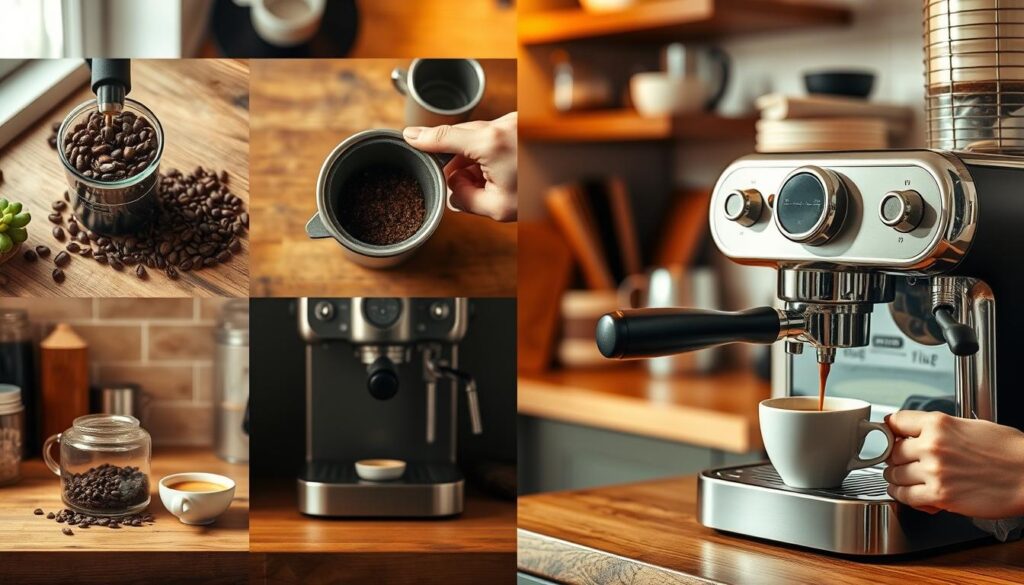
Extracting the Espresso Shot
Put the portafilter into the machine’s group head tightly. Start the espresso making, aiming for 25-30 seconds for a double shot. Watch the espresso’s color and flow to see if it’s good. Getting this right will make your coffee taste better.
Cleaning the Equipment
After enjoying your espresso, clean the machine to keep it working well. Rinse the portafilter and wipe the group head with a damp cloth. Cleaning and descaling regularly will make your machine last longer and keep your espresso tasting great.
Troubleshooting Common Espresso Problems
Even with a detailed homemade espresso guide, you might still face problems. Issues like sour or bitter tastes, wrong crema, and machine pressure problems can occur. Knowing how to fix these can help you make a perfect espresso every time.
Sour Taste: If your espresso tastes sour, it’s probably under-extracted. Here’s how to fix it:
- Make sure your grind is fine enough for good extraction.
- Check that the water is between 195°F and 205°F.
- Try increasing the extraction time a bit by adjusting your tamping.
Bitter Taste: A bitter espresso means it’s over-extracted. To fix this:
- Use a coarser grind to let water flow faster.
- Shorten the extraction time to 25-30 seconds.
- Keep the water temperature below 205°F.
Improper Crema: Getting the crema right depends on a few things:
- Use freshly roasted coffee beans.
- Keep your grind size consistent and proper.
- Make sure your espresso machine is clean and well-maintained.
Machine Pressure Issues: If you have pressure problems, try these steps:
- Check that your machine’s pressure gauge works right.
- Regularly clean and descale your machine to avoid clogs.
- Make sure the portafilter is tightly locked during extraction.
Knowing how to tackle these common problems can make your espresso-making better. Always refer to your homemade espresso guide to improve and solve any issues you face.
Experimenting with Espresso Recipes
Creating different espresso recipes is fun and rewarding, especially when you make espresso at home. Here are some easy espresso recipes for beginners. They will help you try new things and impress your friends.
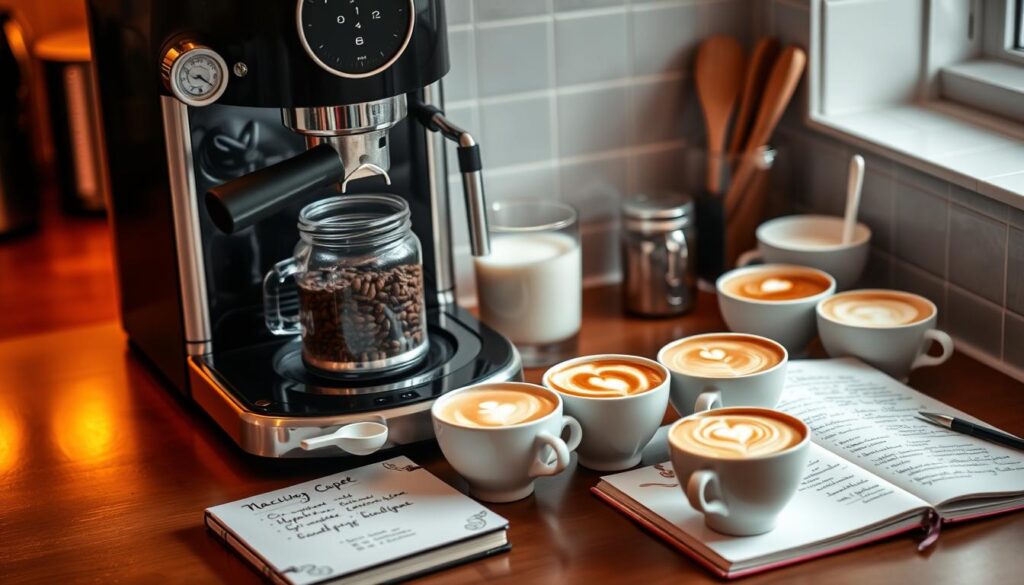
Classic Espresso
The classic espresso shot is a key drink for coffee lovers. Start by grinding your coffee beans finely. Make sure your espresso machine is ready. You should get a thick, creamy coffee shot with rich flavors and smells.
Latte
If you like your coffee creamy, try a latte. First, make a classic espresso shot. Then, steam milk to make a microfoam. Pour the steamed milk over the espresso for a smooth mix of coffee and milk. You can add vanilla or hazelnut syrup for extra flavor.
Cappuccino
A cappuccino mixes strong espresso with steamed milk and foam. Pull your espresso shot and steam your milk to make a thick foam. Pour equal parts of espresso, steamed milk, and foam into a cup for a frothy coffee drink.
Macchiato
The macchiato is great for those who want a strong coffee taste with a bit of milk. There are two types: the espresso macchiato, with a small amount of milk, and the caramel macchiato, with vanilla syrup, steamed milk, espresso, and caramel drizzle.
| Recipe | Ingredients | Instructions |
|---|---|---|
| Classic Espresso | Freshly ground coffee beans | Grind coffee beans finely, pull an espresso shot |
| Latte | Espresso shot, steamed milk | Pull an espresso shot, steam milk, pour milk over espresso |
| Cappuccino | Espresso shot, steamed milk, milk foam | Pull an espresso shot, prepare milk, equal parts espresso, milk, foam |
| Macchiato | Espresso shot, steamed milk or syrups (for caramel macchiato) | Add steamed milk to espresso or layer ingredients as for caramel macchiato |
Trying out these espresso recipes can make your coffee at home better. Whether you’re new or have some experience, these tips will help you enjoy espresso more.
Storing Your Coffee Beans
Keeping your coffee beans fresh and flavorful is key in the homemade espresso guide. The right storage can greatly affect your espresso’s taste. To keep beans fresh, store them in an airtight container. Beans exposed to air can become stale.
Protect your beans from light and heat too. These can lower the quality of your beans. Store your container in a cool, dark spot. An opaque container blocks light well.
There’s a debate on whether to freeze or store beans in a cupboard. Here’s a quick comparison:
| Storage Method | Advantages | Disadvantages |
|---|---|---|
| Freezer | Extends shelf life, reduces exposure to air | Condensation risk, must thaw before use |
| Pantry/Cupboard | Convenient, maintains flavor integrity | Shorter shelf life, careful with humidity |
Each method has its benefits and drawbacks. Many prefer cupboard storage for short-term use and freezing for longer. By following these tips, your coffee beans will stay fresh. This ensures your homemade espresso guide stays top-notch.
Conclusion
In this guide, we explored the art of making espresso at home. We started with the basics of espresso making. Then, we looked at the essential equipment and how to pick the right coffee beans.
Grinding those beans just right is also crucial. We broke down the steps to make espresso at home. This includes setting up your machine, measuring and tamping coffee, and solving common problems.
For beginners, trying out a simple espresso recipe is a great start. You can also try making lattes, cappuccinos, and macchiatos. The secret to getting better at making espresso is to keep practicing.
Keep working on your technique and understanding the different factors that affect your espresso. This will improve your skills over time.
We invite you to dive into this craft with excitement. Share your experiences and successes with other home baristas. Building a community to learn from each other and celebrate small wins is motivating.
Enjoy your espresso journey. May your homemade shots always be flavorful and satisfying!
This website contains affiliate links. As an Amazon Associate, I earn from qualifying purchases. The content on this website was created with the help of AI.

